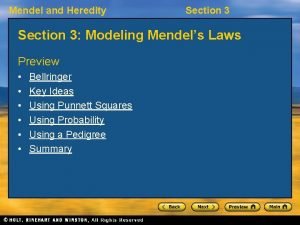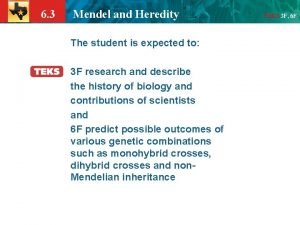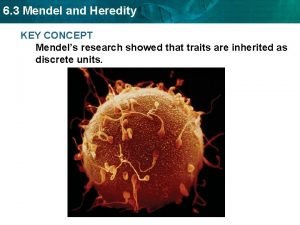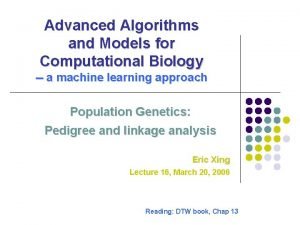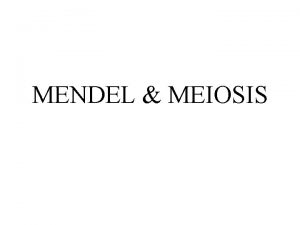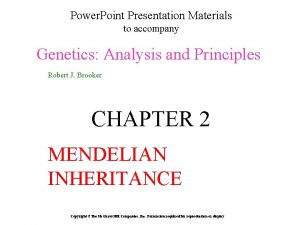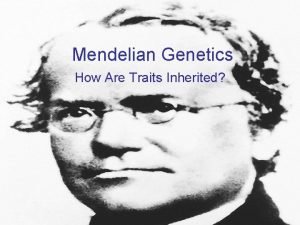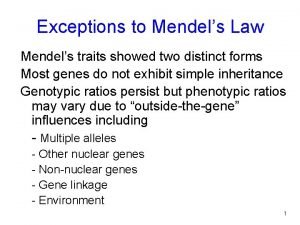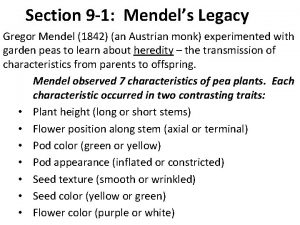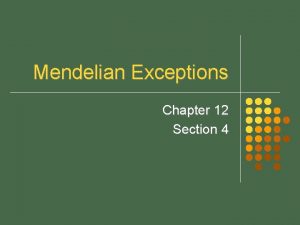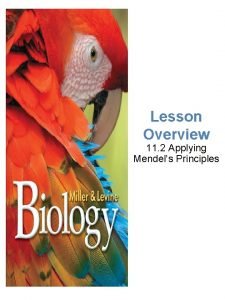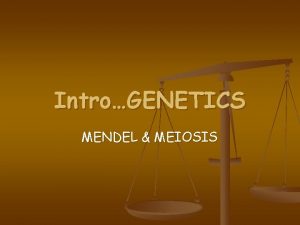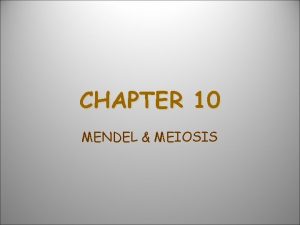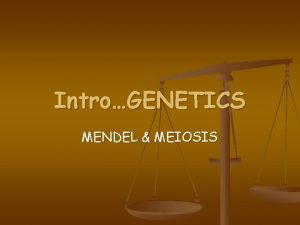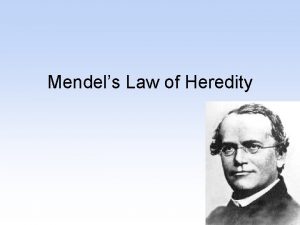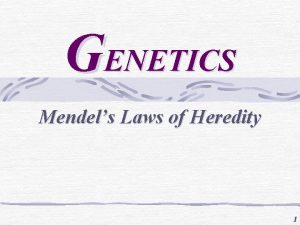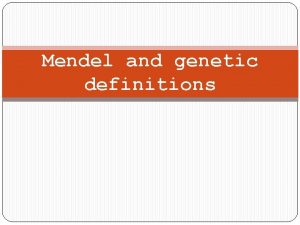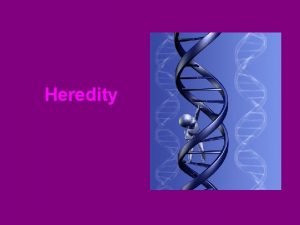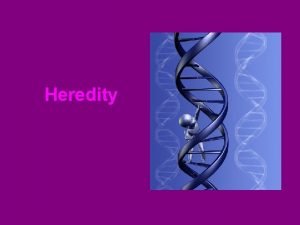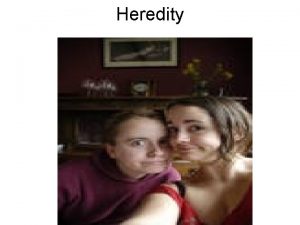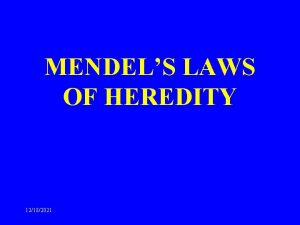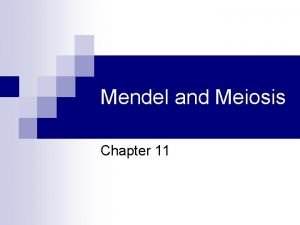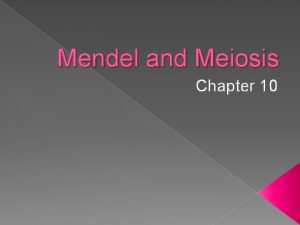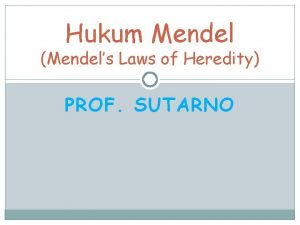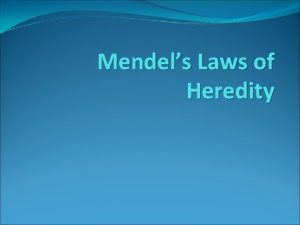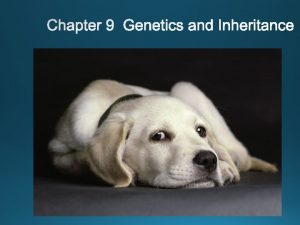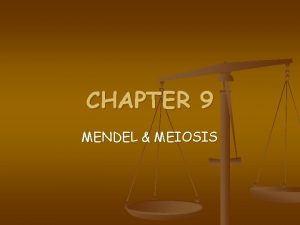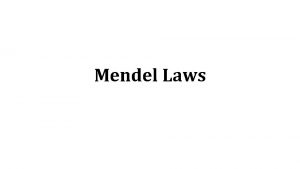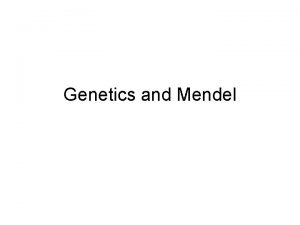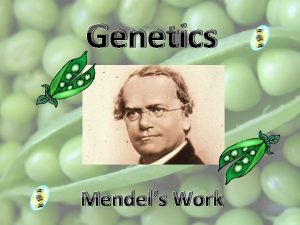Mendel and Meiosis Mendels Laws of Heredity n
























- Slides: 24

Mendel and Meiosis

Mendel’s Laws of Heredity n n Heredity – passing on traits from parents to offspring Gametes – sex cells; they have a haploid number of chromosomes; they have only ½ as many chromosomes as normal cells or one copy of each gene

n n Fertilization – when a male gamete unites with a female gamete Zygote – fertilized cell Gene - chemical factors that determine traits Alleles – different forms of a gene

Mendel’s experiments n n Pea plants are self-pollinating; male and female parts in the same flower Only studied one trait at a time and subjected his data to statistical analysis First cross was between two purebreds or true breeding plants (tall x short) All offspring were tall

Mendel’s experiments (cont) n n n The result was a hybrid with one allele for tall and one for short Then, Mendel allowed the hybrids to selfpollinate (hybrid x hydbrid) Second generation offspring were ¾ tall and ¼ short

Rule of Unit Factors n each organism has two factors/alleles for each trait; the two alleles are located on different copies of a chromosome, one from each parent

Rule of Dominance n in a hybrid where only one trait can be observed, that trait is said to be dominant over the trait that is not visible; the other trait is said to be recessive

Law of Segregation n In sexually reproducing organisms, offspring have one gene from each parent, these are segregated in gamete (sex cell) formation

Law of Independent Assortment n genes for different traits are inherited independently of each other

Phenotypes and Genotypes n n Phenotype – physical appearance of a trait in an organism Genotype – gene/allele combination of an organism Homozygous – organism that has two of the same alleles for each trait Heterozygous – organism that has two different alleles for each trait

Crosses Monohybrid cross – Mendel’s first crosses; studying one trait and its inheritance at a time n Dihybrid cross – studies the relationship between the inheritance of 2 traits n

Punnett Squares n Monohybrid cross (one trait) is a two by two grid ¨ One parent’s genotype is listed at the top; one allele per column ¨ The other parent’s genotype is listed along the side; one allele per row ¨ Squares are filled in with one allele from one parent (top) and one from the other (side)

Dihybrid cross (two traits) is a four by four grid n Very similar to the monohybrid cross, but you must account for all possible gene combinations from parents n

probability n n n chance that you will get one result over another Punnett squares are a way to determine probability the more data you have, the closer to the predicted probability your results should be

Meiosis

Genes and chromosomes n n Diploid – 2 n - cell/organism that contains two of each type of chromosome (one copy from each parent) Haploid – n - cell (sex cell) that contains only one copy of each type of chromosome

n n Homologous chromosomes – two chromosomes of the same type or a pair of similar chromosomes in a diploid cell Meiosis – process of cell division that reduces the number of chromosomes in a cell from diploid to haploid; used for reproduction sperm – male gametes ¨ egg – female gametes ¨

Meiosis I – similar to mitosis n n EXCEPT: In Prophase I, homologous chromosomes come together as tetrads during metaphase I, tetrads line up along the center of the spindle the tetrad is pulled apart during anaphase I, so the homologs are now separate from each other in two different cells

n when tetrad are formed, crossing over may happen; this basically means that homologous chromosomes could “trade ends

Meiosis II n n no chromosome replication before meiosis II chromosomes line up along center of spindle in metaphase II sister chromatids are pulled apart in anaphase II result of both divisions together is 4 haploid cells

Genetic Recombination n n Crossing over just refers to “trading ends” between homologous chromosomes during the tetrad grouping in prophase I and metaphase I Also caused by the law of independent assortment; different chromosomes will be segregated independently of one another

Nondisjunction n n when chromosomes fail to separate properly during meiosis Monosomy – lacking a chromosome Trisomy – extra chromosome Tetrasomy – 2 extra chromosomes

Polyploidy n n n Organisms have more than 1 set of chromosomes Rare in animals; usually results in death or, in humans, mental retardation Plants have a higher occurance rate; can create a “better” or healthier plant, commercially or biologically

Gene Linkage and Maps n n n Genes on the same chromosome are said to be linked If they are far apart on the chromosome, crossing over is more frequent genes maps are charts of chromosomes with gene locations on them (ex. Human Genome Project)
 Section 3 mendel and heredity
Section 3 mendel and heredity Section 3 mendel and heredity
Section 3 mendel and heredity Section 3 mendel and heredity
Section 3 mendel and heredity Section 3 mendel and heredity
Section 3 mendel and heredity Section 3 mendel and heredity
Section 3 mendel and heredity Mendels two laws
Mendels two laws Mendel laws
Mendel laws Mendel experiments in plant hybridization
Mendel experiments in plant hybridization Mendel meiosis
Mendel meiosis Concept mapping chapter 10 meiosis 1 and meiosis 2
Concept mapping chapter 10 meiosis 1 and meiosis 2 What is the difference between mitosis and meiosis 2
What is the difference between mitosis and meiosis 2 Study guide chapter 10 section 1 meiosis
Study guide chapter 10 section 1 meiosis Chapter 10 section 10.2 meiosis worksheet answer key
Chapter 10 section 10.2 meiosis worksheet answer key Gregor mendel laws
Gregor mendel laws Gregor mendel laws
Gregor mendel laws Gregor mendel
Gregor mendel Exception to mendel's laws
Exception to mendel's laws Phases of meiosis
Phases of meiosis Meisis 1 and 2
Meisis 1 and 2 Meiosis 1 vs meiosis 2
Meiosis 1 vs meiosis 2 Charles de secondat
Charles de secondat 9-1 mendels legacy
9-1 mendels legacy Who was mendal
Who was mendal Chapter 12 lesson 2 applying mendels principles
Chapter 12 lesson 2 applying mendels principles Applying mendel's principles
Applying mendel's principles
